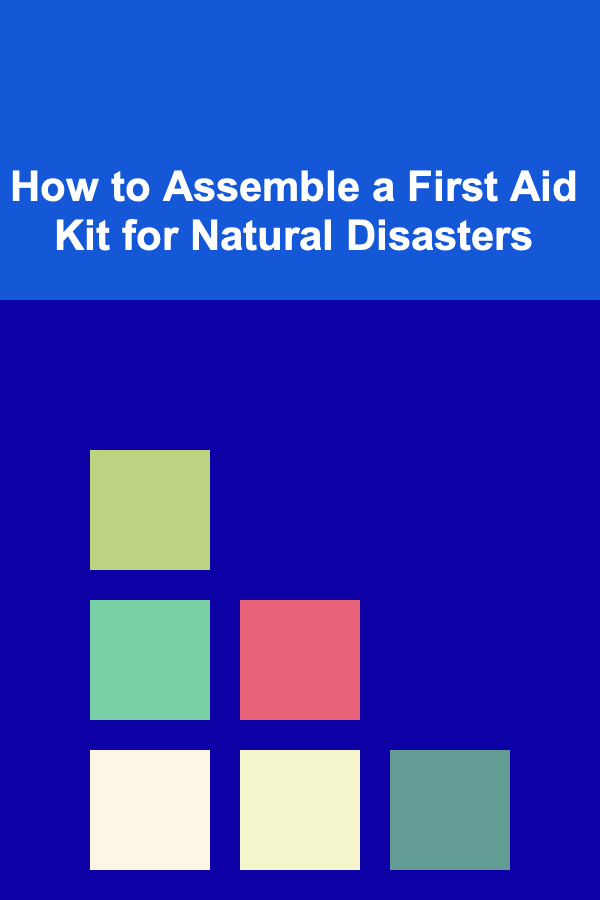
How to Assemble a First Aid Kit for Natural Disasters
ebook include PDF & Audio bundle (Micro Guide)
$12.99$11.99
Limited Time Offer! Order within the next:

Natural disasters can strike at any moment, and being prepared is crucial to ensuring the safety and well-being of you and your loved ones. While having emergency supplies for survival is important, a first aid kit tailored to natural disasters is equally essential. It can help manage injuries, illnesses, and various medical emergencies until professional help arrives or conditions improve.
In this article, we will walk you through the steps for assembling a comprehensive and practical first aid kit for natural disasters. This kit will address the potential medical needs you may face during events like hurricanes, earthquakes, wildfires, floods, and more.
Understand the Specific Risks of Your Area
Before gathering supplies for your first aid kit, it's essential to understand the types of natural disasters that are most likely to occur in your region. This will help you determine the kinds of injuries and health issues that are more likely to arise. For example, if you live in an area prone to earthquakes, you should prioritize supplies for treating fractures or spinal injuries. If you're in a flood zone, you might need extra items for wound care due to contaminated water.
Common Natural Disasters and Associated Risks:
- Hurricanes: Wind and flood injuries, hypothermia, dehydration, and respiratory issues due to mold and mildew.
- Earthquakes: Broken bones, head injuries, cuts, burns, and crush injuries.
- Wildfires: Burns, smoke inhalation, dehydration, and eye injuries.
- Floods: Drowning, waterborne diseases, wound infections, and dehydration.
- Tornadoes: Trauma from flying debris, fractures, and cuts.
By understanding the risks, you can tailor your first aid kit to address the most pressing medical concerns specific to your location.
Essential Medical Supplies for Your Kit
Once you've identified the specific needs for your region, you can begin gathering essential medical supplies. These supplies should be versatile enough to handle a range of injuries and conditions. Here is a comprehensive list of must-have items for your first aid kit:
Basic First Aid Essentials:
- Adhesive Bandages: For small cuts and abrasions.
- Gauze Pads and Dressings: Used to cover larger wounds and control bleeding.
- Adhesive Tape: To secure bandages and gauze pads.
- Antiseptic Wipes or Solution: For cleaning wounds to prevent infection.
- Antibiotic Ointment: To apply to cuts or abrasions after cleaning to prevent infection.
- Sterile Gloves: To avoid cross-contamination when treating wounds.
- Cotton Balls or Swabs: Useful for applying ointments or cleaning small areas.
Tools for Wound Care:
- Tweezers: To remove splinters, glass, or other debris from wounds.
- Scissors: For cutting tape, gauze, or clothing in an emergency.
- Thermometer: To monitor body temperature for signs of infection or heatstroke.
- Elastic Bandage (e.g., Ace Bandage): For sprains or strains.
- Instant Cold Pack: To reduce swelling or pain from sprains, burns, or injuries.
- Burn Gel or Cream: To treat minor burns or sunburns.
Medications:
- Pain Relievers: Acetaminophen (Tylenol), ibuprofen (Advil), or aspirin.
- Antihistamines: To treat allergic reactions from insect stings or food allergies.
- Anti-diarrheal Medication: For gastrointestinal distress, especially in situations where clean water is hard to come by.
- Anti-nausea Medication: To manage motion sickness or nausea.
- Hydrocortisone Cream: To relieve itching from rashes, insect bites, or allergic reactions.
Specialized Medical Supplies:
- Splints: To immobilize broken bones or sprains until professional care can be administered.
- Thermal Blankets: To retain body heat in case of hypothermia, which is common after certain natural disasters like hurricanes or floods.
- Eye Wash: To flush out debris or chemicals from the eyes, particularly useful after wildfires or in flood-prone areas with contaminated water.
- CPR Mask: To perform mouth-to-mouth resuscitation while minimizing the risk of disease transmission.
Hygiene Supplies:
- Hand Sanitizer: When soap and water are not available, alcohol-based hand sanitizer can help prevent infections.
- Wet Wipes: Useful for cleaning wounds, as well as personal hygiene when resources are limited.
- Face Masks: To prevent inhaling dust, smoke, or other harmful particles, particularly after natural disasters like wildfires or during flood clean-up.
Include Supplies for Special Medical Needs
If you or someone in your household has specific medical needs, it's essential to include items that address those needs in your first aid kit. This will ensure that you can manage medical conditions until you have access to professional care. Some supplies to consider:
- Prescription Medications: Always have a 7-10 day supply of essential medications for any chronic conditions, such as asthma inhalers, insulin, or heart medication.
- Allergy Medications: If you or a family member has severe allergies, include an epinephrine auto-injector (EpiPen) in your kit.
- Childcare or Infant Supplies: If you have young children, include baby wipes, formula, and any necessary medications for them.
- Pet First Aid Supplies: If you have pets, consider adding pet-specific medical supplies, such as pet bandages, flea and tick prevention, and any medication your pets require.
Organize and Store Your First Aid Kit
Now that you've gathered the necessary supplies, the next step is to organize and store your first aid kit in a way that makes it easy to access during an emergency. Here's how to organize your kit effectively:
Choose a Durable, Waterproof Container
- Container Size: The container should be large enough to hold all your supplies, but not so large that it becomes difficult to carry.
- Waterproofing: Ensure that the container is waterproof to keep the contents dry in case of flooding or exposure to rain.
Organize the Contents by Category
- Create compartments or use clear plastic bags to separate different categories of supplies (bandages, medications, tools, etc.). This makes it easier to locate items quickly when needed.
- Label: If you're storing multiple kits, or if the container has many items, label sections or bags so you can easily find what you need in an emergency.
Keep the Kit Accessible
- Easy access: Store your first aid kit in a location that is easy to access but out of reach of small children or pets. Make sure all family members know where it is located.
- Portable: Consider having smaller, portable kits that can be easily carried if you need to evacuate quickly.
Prepare for Evacuation
In the event of a natural disaster, you may need to evacuate your home. In such cases, it's important to have a "go bag" that includes not just your first aid kit, but other emergency supplies as well.
What to Include in a Go Bag:
- First Aid Kit: Your comprehensive first aid kit.
- Water: A minimum of one gallon of water per person per day for at least three days.
- Non-perishable Food: High-energy, easy-to-carry foods like protein bars, canned goods, and dried fruits.
- Flashlight and Extra Batteries: For navigating dark environments if the power goes out.
- Portable Power Bank: To charge cell phones and other critical devices.
- Personal Identification: Important documents like ID, insurance, and medical records in a waterproof container.
- Clothing and Personal Items: A change of clothes, blankets, and hygiene supplies.
By assembling a go-bag with your first aid kit and essential items, you'll be ready to evacuate at a moment's notice, ensuring you have the resources you need to manage health issues and stay safe.
Train Yourself and Family Members in Basic First Aid
Having a well-stocked first aid kit is important, but knowing how to use it is just as critical. Make sure that you and your family members are familiar with basic first aid skills and know how to respond in an emergency. Consider taking a first aid and CPR course through the Red Cross or a local organization to improve your knowledge and confidence.
Skills to Learn:
- CPR (Cardiopulmonary Resuscitation): Knowing how to perform CPR can save a life in the event of cardiac arrest.
- Basic Wound Care: Learn how to clean and dress wounds, as well as how to manage severe bleeding.
- Splinting: Knowing how to properly splint a broken bone can prevent further injury until medical help arrives.
- Burn Treatment: Understand how to treat burns and what to do in case of smoke inhalation.
Regularly Check and Update Your First Aid Kit
It's important to check your first aid kit regularly to ensure that all supplies are in good condition and that nothing has expired. Medications, bandages, and other supplies can deteriorate over time, so a quick inspection every six months is a good practice.
- Replace expired items: Check the expiration dates on medications and replace them as needed.
- Replenish used supplies: If you've used any items in your first aid kit, replace them immediately so the kit is always ready.
- Refill personal medications: Ensure that you always have a sufficient supply of any necessary prescription medications.
Conclusion
Assembling a first aid kit for natural disasters is an essential step in preparing for emergencies. By understanding the risks specific to your region, gathering the right supplies, and organizing your kit effectively, you can provide crucial medical care to yourself and others in times of need. Equally important is ensuring that you and your family are trained in basic first aid and that you keep your kit up-to-date and ready for any situation.
With proper preparation, you can face the challenges of natural disasters with confidence, knowing that you have the tools and knowledge to help those in need. Always remember, when it comes to emergencies, being prepared can make all the difference.
Reading More From Our Other Websites
- [Home Lighting 101] How to Use Task Lighting for Better Functionality in Your Home
- [Paragliding Tip 101] How to Perform a Safe Pre‑Flight Inspection on a Two‑Person Tandem Paraglider
- [Home Space Saving 101] How to Use Vertical Space for Maximum Storage Efficiency
- [Biking 101] Top 5 Spin Bikes for Effective Indoor Workouts
- [Home Lighting 101] How to Select the Best Lighting for Your Home's Color Scheme
- [Personal Care Tips 101] How to Make Your Own Natural Conditioner at Home
- [Reading Habit Tip 101] Simple Daily Hacks to Carve Out More Reading Time
- [Home Cleaning 101] How to Keep Your Home Clean When You Have Small Children
- [Personal Care Tips 101] How to Choose the Right Conditioner for Your Hair Type
- [Home Lighting 101] How to Incorporate Sconces for Elegant Wall Lighting

How to Incorporate Space-Saving Cabinets for Bedroom Organization
Read More
How to Make Money Online as a Dropshipper
Read More
The Corporate Trainer's Guide: Mastering the Art of Effective Employee Development
Read More
How to Pack Party Favor Boxes for Safe Shipping
Read More
How to Design Memory Games for People with Dementia
Read More
How to Design a Prayer Planner for Specific Needs
Read MoreOther Products

How to Incorporate Space-Saving Cabinets for Bedroom Organization
Read More
How to Make Money Online as a Dropshipper
Read More
The Corporate Trainer's Guide: Mastering the Art of Effective Employee Development
Read More
How to Pack Party Favor Boxes for Safe Shipping
Read More
How to Design Memory Games for People with Dementia
Read More